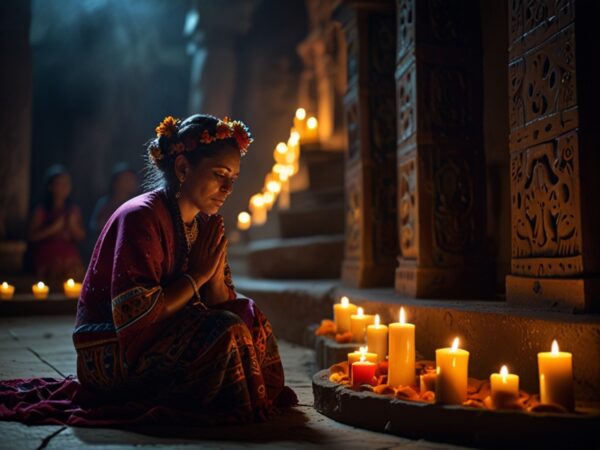
For those of you exploring the heart of Mexican culture or choosing to call Mexico home, there’s no better way to dive into the country’s rich traditions than experiencing Día de los Muertos, or Day of the Dead, in Yucatán. Forget the clichés of painted skulls and Halloween-like interpretations; here, you’ll find that this ancient tradition is more about love, memory, and connection with those who’ve passed on.
The Soulful Celebration of Día de los Muertos
Día de los Muertos is celebrated on November 1st and 2nd, but in Yucatán, it’s part of a longer tradition called Hanal Pixán, which means “Food for the Souls” in Maya. The belief is that these days, the spirits of loved ones come back to visit, and Yucatecans welcome them with open arms and plenty of food. Unlike the sugar skulls and parades you may have seen in places like Mexico City, the emphasis is on quiet reverence and intimate gatherings here.
What You’ll Experience
- Altars with Heart: The centerpiece of the celebration is the altar, known as ofrenda. Yucatecan families create these with a meticulous touch, adding photographs of the deceased, crosses, marigold petals, and items their loved ones cherished. But the real magic lies in the food offered. Expect to see mucbipollo, a traditional Yucatecan dish that’s like a giant tamal stuffed with pork or chicken and wrapped in banana leaves before being buried in the ground to cook. It’s a dish with layers of meaning and flavor—heavy, earthy, and fulfilling.
- Walk Through the Paseo de las Ánimas: In Mérida, the Paseo de las Ánimas (Walk of the Souls) is the star event, where the city comes alive in memory of the dead. Hundreds of people walk through the streets, dressed as catrinas or in traditional Maya garb, leading you into a surreal journey of culture and spirituality. The streets are lined with altars, vibrant decorations, and the faint scent of copal incense that’s meant to guide the souls.
- Pib Pit-Cooking: If you have the chance, try to witness pib pit-cooking. The preparation is almost as important as the meal itself—a whole community effort involving building a pit, lighting a fire, and covering the mucbipollo to cook underground. It’s like a barbecue with a soul, blending flavors and traditions in each bite.
Tips for Expats to Enjoy Día de los Muertos
Tips for Expats to Enjoy Día de los Muertos
- Be Respectful, Not Spectacular: Day of the Dead in Yucatán isn’t about the spectacle. Observe with curiosity and respect. Remember, these aren’t just decorations—they’re memories. Take your time to ask locals about the stories behind their altars. They’ll appreciate it more than just a photo op.
- Try the Local Dishes: Food is central to Hanal Pixán. Aside from mucbipollo, try pan de muerto, a slightly sweet bread with a hint of orange zest, perfect to pair with a cup of hot chocolate. Don’t miss out on atole, a thick corn-based drink, often flavored with chocolate, vanilla, or fruit.
- Practice Your Spanish (or Maya!): Many Yucatecans are bilingual in Spanish and Maya. Even if your language skills aren’t great, showing an effort to say simple greetings like “K’íin wóolal” (good afternoon) or “Bix a beel” (how are you?) in Maya can be a great icebreaker.
Fun Facts about Día de los Muertos in Yucatán
- Yucatán vs. the Rest of Mexico: While many regions in Mexico celebrate with parades and music, Yucatán’s observance is more subdued and intimate, reflecting its deep Maya roots.
- A Return to Tradition: Hanal Pixán was almost forgotten in the mid-20th century, but in the last 30 years, efforts to revive Maya culture have brought it back into full bloom, especially in towns like Peto and Valladolid.
- Mucbipollo’s Name: The dish’s name comes from the Maya words “muc” (buried) and “bil” (wrapped). Literally, it’s the ‘buried package,’ and tasting it feels like being handed a little piece of Yucatán’s culinary history.
Final Words: Go with Open Hearts
If you’re planning to visit or you’ve already made Mexico your new home, let Día de los Muertos in Yucatán be an opportunity to embrace the blending of the old and the new, the living and the dead. You won’t just learn about the culture; you’ll understand it in a way that only heartfelt traditions like this can allow. Leave room for conversation, food, and moments that stay with you long after November 2nd.
So, bring an appetite, an open heart, and a sense of wonder. And when in doubt, remember that here, it’s less about mourning the dead and more about celebrating the beauty of life—one dish, one story, and one altar at a time.
Comments are closed